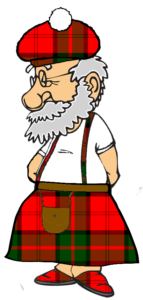Clan Dunbar
 Gospatrick the 1st, in the 10th century, was said to be the first to bear the name Dunbar. Dunbar is derived from the Gaelic word dun meaning fort, and barr meaning summit. In the 11th century Gospartrick was granted lands at Dunbar after he was involved in an uprising against William the Conquer and exiled out of England. His family held the title of Earl of Dunbar until 1435.
Gospatrick the 1st, in the 10th century, was said to be the first to bear the name Dunbar. Dunbar is derived from the Gaelic word dun meaning fort, and barr meaning summit. In the 11th century Gospartrick was granted lands at Dunbar after he was involved in an uprising against William the Conquer and exiled out of England. His family held the title of Earl of Dunbar until 1435.
The Dunbar motto is, In Promptu, meaning, in readiness, and the crest of the clan features a horse’s head, reined and bridled.
 The historic seat of the clan is in Dunbar Castle in the town of Dunbar, East Lothian. The castle is thought to have been built by Gospatric after receiving the lands from Malcolm the third of Scotland sometime in the 11th century.
The historic seat of the clan is in Dunbar Castle in the town of Dunbar, East Lothian. The castle is thought to have been built by Gospatric after receiving the lands from Malcolm the third of Scotland sometime in the 11th century.
In 1420, George the 11th Earl of Dunbar was imprisoned by James I of Scotland on the charge of treason. The Dunbar estates were claimed by the crown. George was the last Earl of Dunbar.

The Clan Dunbar society was formed in 1979 for the purpose of the “promotion and development of the traditional Scottish Arts as they relate to the origins of Scottish related culture”
In 1990 after a celebrated court case the chiefship of the Dunbar clan was recognized. The case was first heard in front of the Lord Lyon King of Arms, moved on to the Supreme court and was finally settled by the House of Lords. Sir Jean Ivor Dunbard, who was the 13th Baronet of Mochrum, was named chief of the clan.

